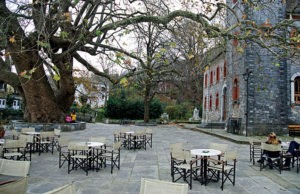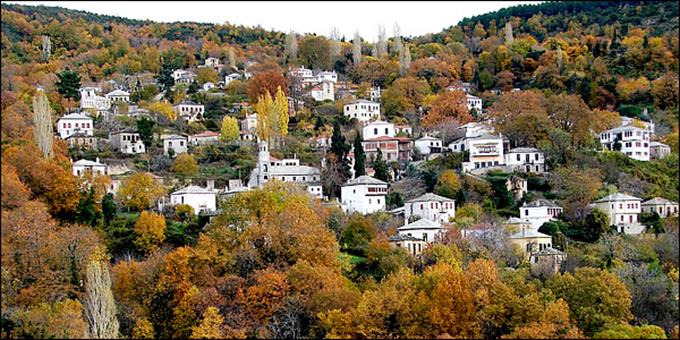Pelion is a mountain in the Prefecture of Magnesia next to the city of Volos, at a height of 1,624 meters (the peak of the Purian Cross).
In Greek mythology was the summer residence of the gods and the homeland of the Centaurs. It extends from the northwest to the southeast with an approximate length of 44km and a width ranging from 10km in the south to 25km in the north and at 39.44N 23.04E coordinates. Approximately its boundary is south of Platanorema near Neochori and north of Kaporema near Flamouri monastery. Its tallest peak is on the north side of the mountain and is not accessible due to the existence of military facilities. Other peaks are Kotrooni 1550 meters, Plyssidi 1547 meters, Agrodaki 1537 meters, Agriolefkes 1471 meters, Dramallas 1455 meters, Skiing 1450 meters, Calvary 1415 meters, Lagundo 1300 meters.
The whole mountain is full of forests with towering beeches, oak trees, plane trees, wild chestnut trees, forest pine trees, as well as hybrids of fir.
At lower altitudes there are groves with apple trees on the eastern slopes, olive groves in the south and very dense vegetation. Particular characteristic is its hydrological nature as the eastern slopes receive very large amounts of rain and snow that far exceed the average price of lowland Thessaly. Despite the presence of 70% of shale rocks that would not allow the creation of significant underground sources, the existence of large cracks has led to the creation of remarkable sources. The most important of them are those of Kaliakouda and Lagonika. In total, the well-known sources in the mountain reach 70. Rivers with steady flow do not exist in Pelion, but large ravines, such as Lagonika, Vrychonas, Kaliakouda and Fellakouka, with a significant flow in the winter and spring months as well as dozens of small streams.
 Pelion gathers enough visitors, both in the winter and in the summer months. Winter is preferred by those who wish to enjoy the beautiful mountain and the fresh air, the snow, skiing, spending time in nature, while in the summer holidaymakers enjoy the beautiful beaches of Pelion for swimming, racquets, water sports, trekking, etc. Pelion remains beautiful all months and is suitable for any kind of activity, as well as for alternative tourism or agrotourism, while it also has the appropriate infrastructure for hosting a large number of holidaymakers. Pelion has rich vegetation throughout the year. Mainly apples, pears, peaches, lemons, almonds, chestnuts, walnuts, olive oil and olives, tea, thyme are grown, while small producers and cooperatives produce such products as spoon sweets, noodles, trachanas, tsipouro, honey and royal jelly. Maintaining the traditions is of particular importance for Pelion because it is an important factor in tourism and economic convenience.
Pelion gathers enough visitors, both in the winter and in the summer months. Winter is preferred by those who wish to enjoy the beautiful mountain and the fresh air, the snow, skiing, spending time in nature, while in the summer holidaymakers enjoy the beautiful beaches of Pelion for swimming, racquets, water sports, trekking, etc. Pelion remains beautiful all months and is suitable for any kind of activity, as well as for alternative tourism or agrotourism, while it also has the appropriate infrastructure for hosting a large number of holidaymakers. Pelion has rich vegetation throughout the year. Mainly apples, pears, peaches, lemons, almonds, chestnuts, walnuts, olive oil and olives, tea, thyme are grown, while small producers and cooperatives produce such products as spoon sweets, noodles, trachanas, tsipouro, honey and royal jelly. Maintaining the traditions is of particular importance for Pelion because it is an important factor in tourism and economic convenience.
All year round, various festivals are held in Pelion where the products are sold and there is a special celebration for each product, such as the chestnut celebration every October in Xurihti. In the villages of Pelion you will find many cooperatives, especially women’s agricultural cooperatives, who produce traditional homemade products. The beaches of Pelion, both from the Aegean Sea and Pagasitikos are famous for their clear blue waters, and many have been awarded the Blue Flag by the European Union. There are beaches for all tastes: quiet or cosmic, organized or not, with sand or pebble. As a rule, the beaches on the side of Pagasitikos are more lean, hotter and have fewer waves than those seen in the Aegean Sea. Indicatively, they refer to:
On the Aegean Sea Mylopotamos Fakistra Pappa Nero Potistika Paltsi Pantazi Ammos Melani Katigiorgis Lyri Theotokos Mourtias Kastri Vromoneri Platanias Mikro Damouchari Saints Saranda Ai-Giannis Chorefto
On the side of the Pagasitic Gulf Kato Gatzea Milina Afissos Kala Nera Pao Kalamos Lefokastro Bouffa Of course the list is endless and is not exhausted here.
The traveler should look not only at drivers but also on his own to discover the beautiful beaches of Pelion. Pelion has a large number of paths that are ideal for gentle, cavalry and cycling touring. The cobblestone paths, together with the Volos-Milies railway line, constituted until the 1950s the unique axis of communication between villages and Volos. Despite the passage of time, many of the old trails are preserved in a very good condition thanks to the care of the local communities, giving the visitor the opportunity to explore the mountain safely and safely.



